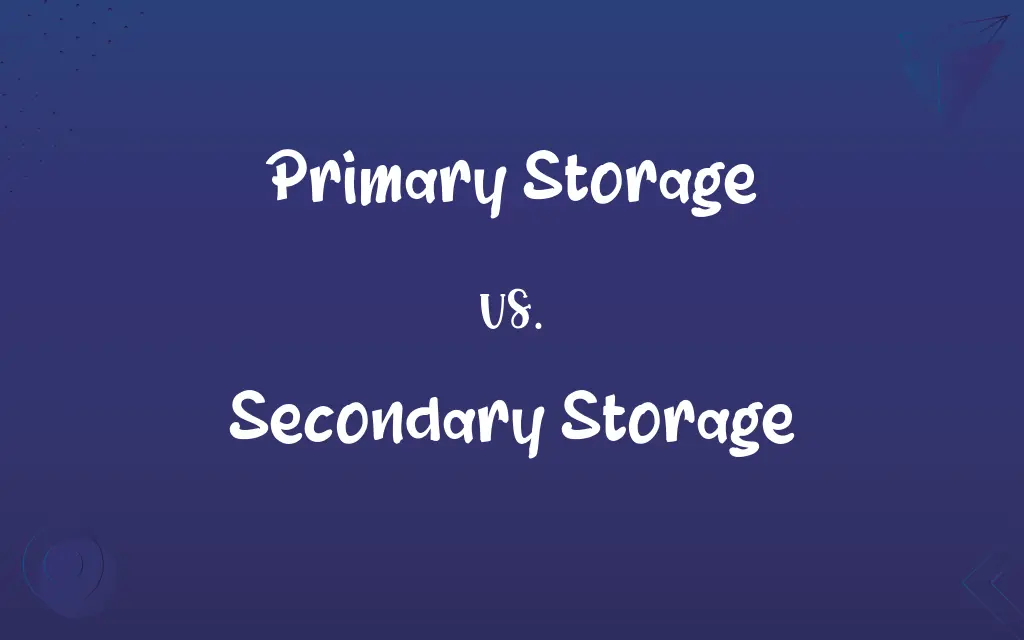Primary Storage vs. Secondary Storage: Know the Difference

By Shumaila Saeed || Published on January 1, 2024
Primary storage is directly accessible by the CPU for immediate data processing, whereas secondary storage provides long-term data storage.

Key Differences
Primary storage, also known as main memory, is directly connected to the central processing unit (CPU) of a computer. It temporarily holds data and instructions that the CPU is actively using. Secondary storage, in contrast, refers to storage devices that are used for storing data on a long-term basis. These devices are not directly accessible by the CPU.
Shumaila Saeed
Jan 01, 2024
The speed of primary storage is significantly higher than that of secondary storage. This is because primary storage is designed to be accessed quickly by the CPU for immediate processing of data and instructions. Secondary storage, on the other hand, is slower but offers greater storage capacity and is used for storing data that is not required for immediate processing.
Shumaila Saeed
Jan 01, 2024
Primary storage is typically more expensive per unit of storage than secondary storage. It includes memory types like RAM (Random Access Memory) and cache memory, which are volatile, meaning the data is lost when power is turned off. Secondary storage includes hard drives, solid-state drives, CDs, and USBs, which retain data even when powered off.
Shumaila Saeed
Jan 01, 2024
The durability and reliability of secondary storage are generally higher than that of primary storage. While primary storage is crucial for a computer’s immediate operations and processing speed, secondary storage is vital for data backup, archiving, and storing large amounts of data securely over time.
Shumaila Saeed
Jan 01, 2024
In terms of capacity, primary storage usually has a much smaller capacity compared to secondary storage. The primary storage is designed to be fast but limited in size due to its higher cost and technological limitations, while secondary storage can hold much larger amounts of data, making it suitable for long-term data storage.
Shumaila Saeed
Jan 01, 2024
ADVERTISEMENT
Comparison Chart
Volatility
Volatile (data lost when powered off)
Non-volatile (retains data)
Shumaila Saeed
Jan 01, 2024
ADVERTISEMENT
Primary Storage and Secondary Storage Definitions
Primary Storage
Primary storage is a high-speed memory directly connected to the CPU.
Upgrading the primary storage significantly boosted the processing speed of the device.
Shumaila Saeed
Dec 19, 2023
Secondary Storage
Secondary storage offers larger storage capacity at a lower cost than primary storage.
To manage its growing data archive, the organization invested in additional secondary storage solutions.
Shumaila Saeed
Dec 19, 2023
Primary Storage
Primary storage serves as a temporary storage area for the computer's processor.
The laptop's primary storage was quickly filled up due to the multiple applications running simultaneously.
Shumaila Saeed
Dec 19, 2023
Secondary Storage
Secondary storage is used for storing large amounts of data outside the computer's main memory.
The company relied on secondary storage devices for backing up its extensive databases.
Shumaila Saeed
Dec 19, 2023
Primary Storage
Primary storage is the computer’s main memory used for temporary data storage.
The increased RAM, a form of primary storage, improved the computer's performance.
Shumaila Saeed
Dec 19, 2023
ADVERTISEMENT
Secondary Storage
Secondary storage is not directly accessible by the CPU and is slower than primary storage.
Accessing files from secondary storage took longer, but it was essential for long-term data retention.
Shumaila Saeed
Dec 19, 2023
Primary Storage
Primary storage is volatile storage directly accessible by the CPU.
During the execution of a program, primary storage plays a critical role in storing the instructions.
Shumaila Saeed
Dec 19, 2023
Secondary Storage
Secondary storage refers to storage devices used for long-term data preservation.
I saved my project files on an external hard drive, a popular type of secondary storage.
Shumaila Saeed
Dec 19, 2023
Primary Storage
Primary storage is responsible for holding data and programs that are in active use.
The game's high-resolution graphics required substantial primary storage for smooth gameplay.
Shumaila Saeed
Dec 19, 2023
Secondary Storage
Secondary storage is non-volatile, retaining data even after the computer is turned off.
The photographs were safely stored on secondary storage, ensuring their availability despite power outages.
Shumaila Saeed
Dec 19, 2023
Repeatedly Asked Queries
What types of storage are considered primary storage?
RAM (Random Access Memory) and cache memory are common types of primary storage.
Shumaila Saeed
Jan 01, 2024
How does primary storage affect computer performance?
Primary storage directly impacts processing speed and performance, as it's where the CPU accesses data and instructions for processing.
Shumaila Saeed
Jan 01, 2024
Why is primary storage more expensive?
Primary storage is costlier due to its higher speed and the technology required for direct CPU access.
Shumaila Saeed
Jan 01, 2024
What is primary storage?
Primary storage, also known as main memory, is the computer's immediate memory accessible by the CPU for quick data processing.
Shumaila Saeed
Jan 01, 2024
Can you give examples of secondary storage?
Examples include hard drives, solid-state drives, CDs, DVDs, and USB flash drives.
Shumaila Saeed
Jan 01, 2024
How does secondary storage differ in cost compared to primary storage?
Secondary storage is usually less expensive per unit of storage compared to primary storage.
Shumaila Saeed
Jan 01, 2024
How does data volatility differ between primary and secondary storage?
Primary storage is volatile, while secondary storage is non-volatile, retaining data without power.
Shumaila Saeed
Jan 01, 2024
Is secondary storage slower than primary storage?
Yes, secondary storage is generally slower but offers higher capacity for long-term data storage.
Shumaila Saeed
Jan 01, 2024
Are there any reliability differences between the two types of storage?
Secondary storage is generally more durable and reliable for long-term data storage compared to primary storage.
Shumaila Saeed
Jan 01, 2024
Is primary storage volatile or non-volatile?
Primary storage is typically volatile, meaning data is lost when power is turned off.
Shumaila Saeed
Jan 01, 2024
What is secondary storage?
Secondary storage refers to storage devices used for long-term data storage, not directly accessed by the CPU.
Shumaila Saeed
Jan 01, 2024
Why is secondary storage important?
It's crucial for backing up data, archiving, and storing large amounts of information securely.
Shumaila Saeed
Jan 01, 2024
What role does secondary storage play in data backup?
It's essential for data backup, providing a secure and long-term storage solution for important data.
Shumaila Saeed
Jan 01, 2024
What is the role of secondary storage in cloud computing?
In cloud computing, secondary storage is used to store large volumes of data remotely, providing scalability and accessibility.
Shumaila Saeed
Jan 01, 2024
What is the capacity comparison between primary and secondary storage?
Primary storage has a smaller capacity, while secondary storage can hold much larger amounts of data.
Shumaila Saeed
Jan 01, 2024
Can data be transferred between primary and secondary storage?
Yes, data can be moved between the two, with primary storage used for immediate processing and secondary for longer-term storage.
Shumaila Saeed
Jan 01, 2024
How does the speed of data access compare between primary and secondary storage?
Data access is faster in primary storage due to its direct connection to the CPU, while secondary storage is slower.
Shumaila Saeed
Jan 01, 2024
Can primary storage be expanded easily?
Expanding primary storage is possible but can be costly and depends on the computer's hardware limitations.
Shumaila Saeed
Jan 01, 2024
What are the environmental considerations for secondary storage?
Secondary storage devices should be kept in a stable environment to protect them from physical and magnetic damage.
Shumaila Saeed
Jan 01, 2024
How do advancements in technology affect primary storage?
Technological advancements lead to faster, more efficient primary storage, enhancing overall computer performance.
Shumaila Saeed
Jan 01, 2024
Share this page
Link for your blog / website
HTML
Link to share via messenger
About Author
Written by
Shumaila SaeedShumaila Saeed, an expert content creator with 6 years of experience, specializes in distilling complex topics into easily digestible comparisons, shining a light on the nuances that both inform and educate readers with clarity and accuracy.




































































